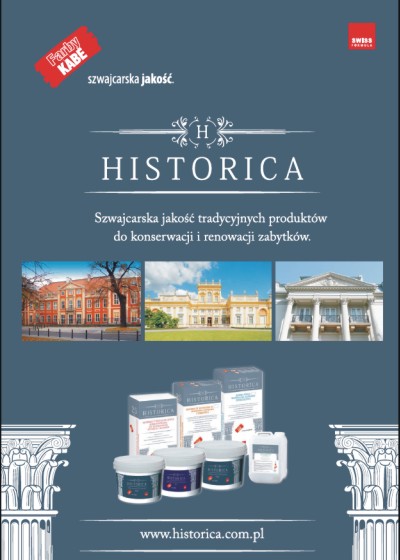Category: Mass media about us
The article “NOVALIT – polysilicate technology of the 21st century (part II)” was published in the 4/2011 issue of the Renovations and Monuments publishing house.
A wide range of polysilicate products from the NOVALIT line allows them to be used both on the facades of newly constructed buildings and for renovation of existing ones. They are used in the implementation of protective and decorative finishing layers outside and inside buildings, in thermal modernization of external walls, renovation of cracked facades and restoration of historic buildings.
Category: Mass media about us
The “Farby KABE w Warszawie” article was published in the 3/2012 issue of Renovations and Monuments.
You may have admired restored palaces, churches and tenement houses while walking through the picturesque corners of Warsaw. Many of them regained their former glory thanks to the cooperation of professionals from many industries: conservators, architects, constructors, mycologists, etc. with the participation of specialists from Farby KABE Polska.
Category: Mass media about us
The article “Farby KABE on Cracow Elevations” was published in the 1/2012 issue of the Renovations and Monuments Publishing House.
The Farby KABE brand has been present on the Polish market since 1995, where it constantly strengthens its position. It has been trusted not only by users and individual investors, but also, which is very important for the company, by contractors specializing in restoration and conservation of historic buildings.
Category: Mass media about us
In the 4/2013 issue of Renovation and Monuments, two articles were published: “Products for renovation, Farby KABE Polska” and “MINERALIT RESTAURO System”.
More than 100 years ago, the company KABE Farben Karl Bubenhofer AG, dealing with the renovation of historic buildings, launched
pioneering production of two-component silicate paints. Over the years, KABE Farben has grown steadily production technology of silicate products. At the end of the 1960s, it launched a one-component silicate-dispersion paint, significantly contributing to the renaissance of silicate paints.
Category: Mass media about us
In the 4/2015 issue of Renovation and Monuments, the article “Dampproof and waterproof insulations in historic buildings” was published
One of the more serious problems in construction is moisture. This problem also affects historic buildings. There are many reasons for the formation of increased moisture, including: groundwater levels that change, terrain changes, surroundings reconstruction, etc.Therefore, it is increasingly necessary to use insulation as one of the elements of renovation in historic buildings.
Category: Mass media about us
The article “Historica – material and care for monuments” was published in the 2/2016 issue of Renovations and Monuments.
One of the most important tasks in the conservation activities is the protection of the historic substance. It has always been a challenge for maintenance and restoration specialists. Due to the wide range of definitions of a historic substance, manufacturers of materials must and should take into account the composition and adjust it to the needs and conservation assumptions.
Category: Mass media about us
In the 3/2016 Renovations and Monuments, issue an article “Problems of the renovation of a historic fence” was published.
Moisture and salinity are one of the biggest problems that must be faced during renovation works on historic buildings. Free-standing objects, e.g. fences, are particularly vulnerable to the destructive influence of these factors. This is due to the location of the object, as well as the harmful effect of moisture to which the object is exposed. Flooding with rainwater, splash moisture, salt used during winter road works or finally capillary action are just some of the reasons. The condition of free-standing objects is also influenced by the fact that very often they do not have horizontal insulation, and the securing of the top of the wall is also in a poor technical condition. Structural cracks are also common.
Category: Mass media about us
Category: Mass media about us

Category: Mass media about us
Information on the new HISTORICA product line has been published in the Renovations and Monuments publishing house.
Materials used for the renovation of monuments should meet certain standards and reflect historical manufacturing techniques. The composition of the materials should be as close as possible to the original materials. Only such products can meet the principle of not damaging the historic structure.






